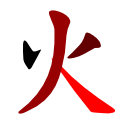Lexicon & background concepts:
CFL lexicon objectives: about 23.000 words (詞) need for newspapers correct reading (Da J. 2005:15-16). In modern texts, it's equal to a words coverage of 95% and above the first 1.600 characters.
Lexical approach: is the now dominant view that the learners should focus on the hight usefulness (=hight frequency) unknow items (Nation 2006). Huoji (this Apps) is based on this usefulness-based lexical approach.
Benefit-Cost approach / Proximal learning: is the emerging view that the learners should focus on the hight usefulness (=hight frequency) and hight easiness (=low learning burden) unknow items since it indeed speed up learning (Barker 2007;Metcalfe 2005,
2006,
2010)
Frequency rank (character, words ~): an important predictor of reading comprehension (Shen H. H., 2005).
Characters by sentence: an important predictor of text difficulty (Da J. 2009:9;19).
Comprehensive input: is the view that learners should focus on items (grammatical or lexical) just a bit over their current level (Krashen & Terell 1983)
Coverage (lexical ~): ratio of understood items VS all items in % (Laufer 2010)
Learning burden / word difficulty / easiness:
Thresholds: limiting line between groups of lexical items, for us, the learner´s vocabulary is divided in known/partially know/unknow (Laufer 1997)
Opacity (Chinese characters ~): Chinese characters being non-phonetic, there is opacity —no certainty to read read an unknow characters—. This sound-graph disconnection slower learning.
Plateau (lexical~): finding that Chinese language learner of intermediate level are usually locked on a lexical level from which they cannot progress due to Chinese opacity (Shi & Wen 2009).
Vocabulary profile: the learner´s current lexical knowledge. Both the number of items and deph of knowledge are usually relevant.

